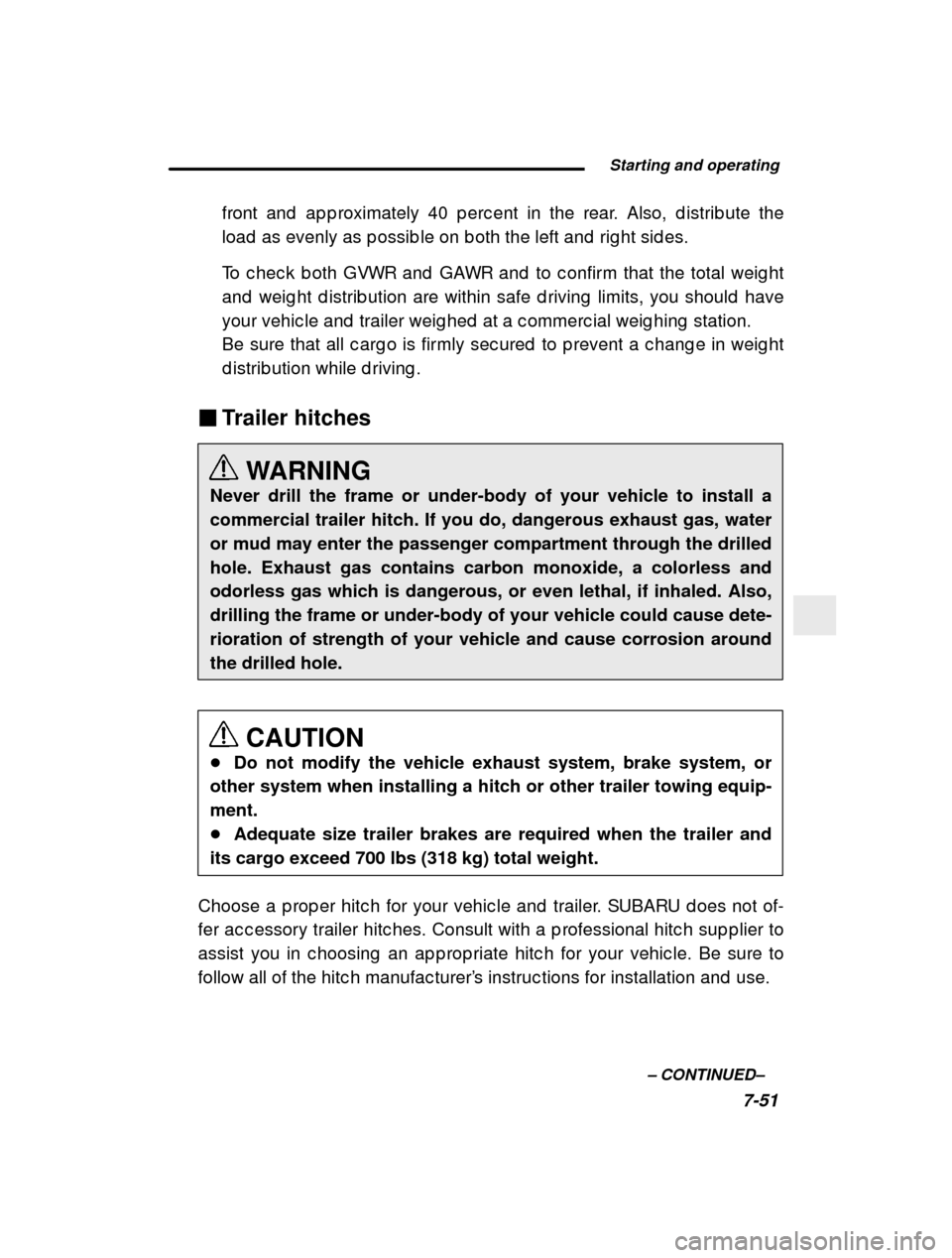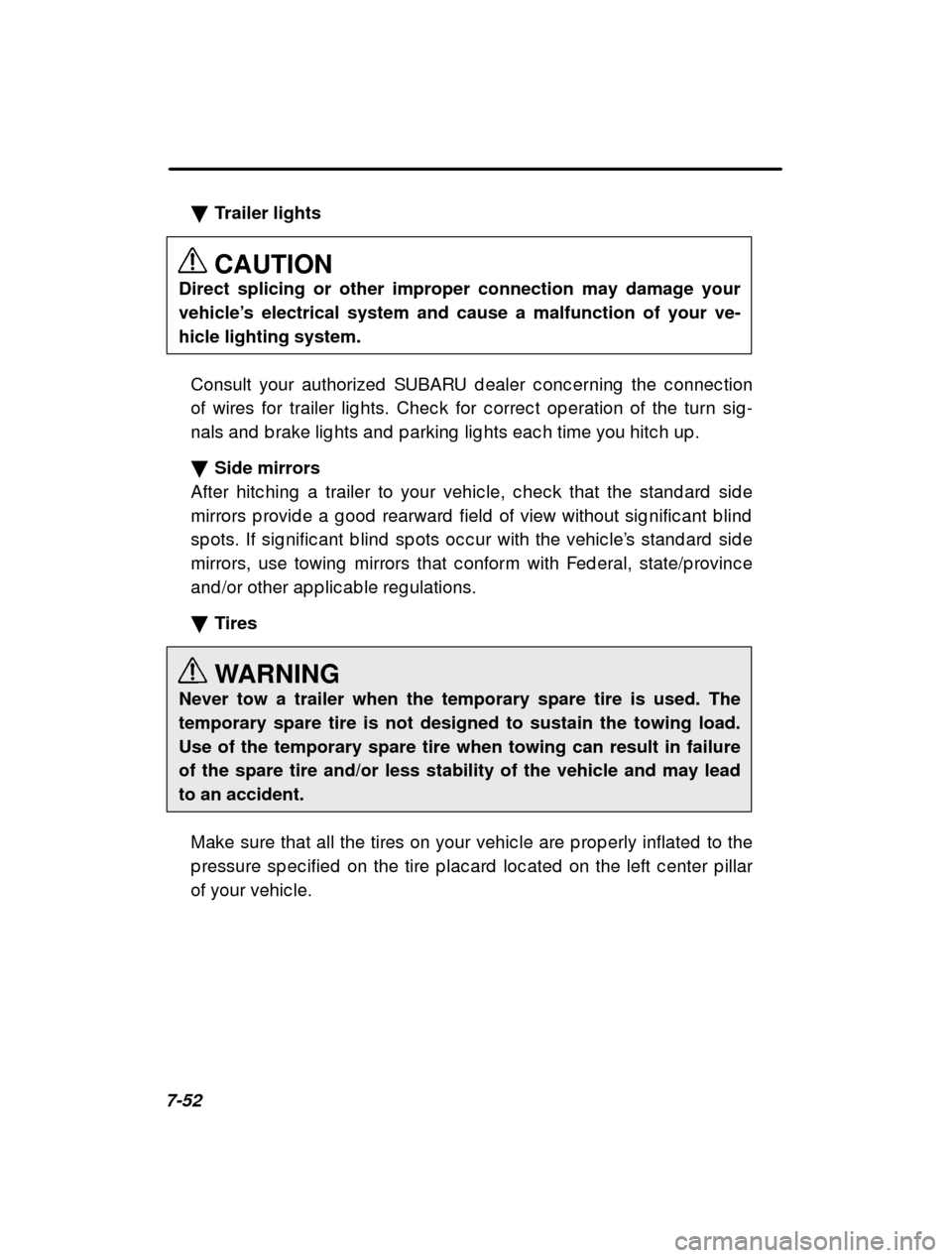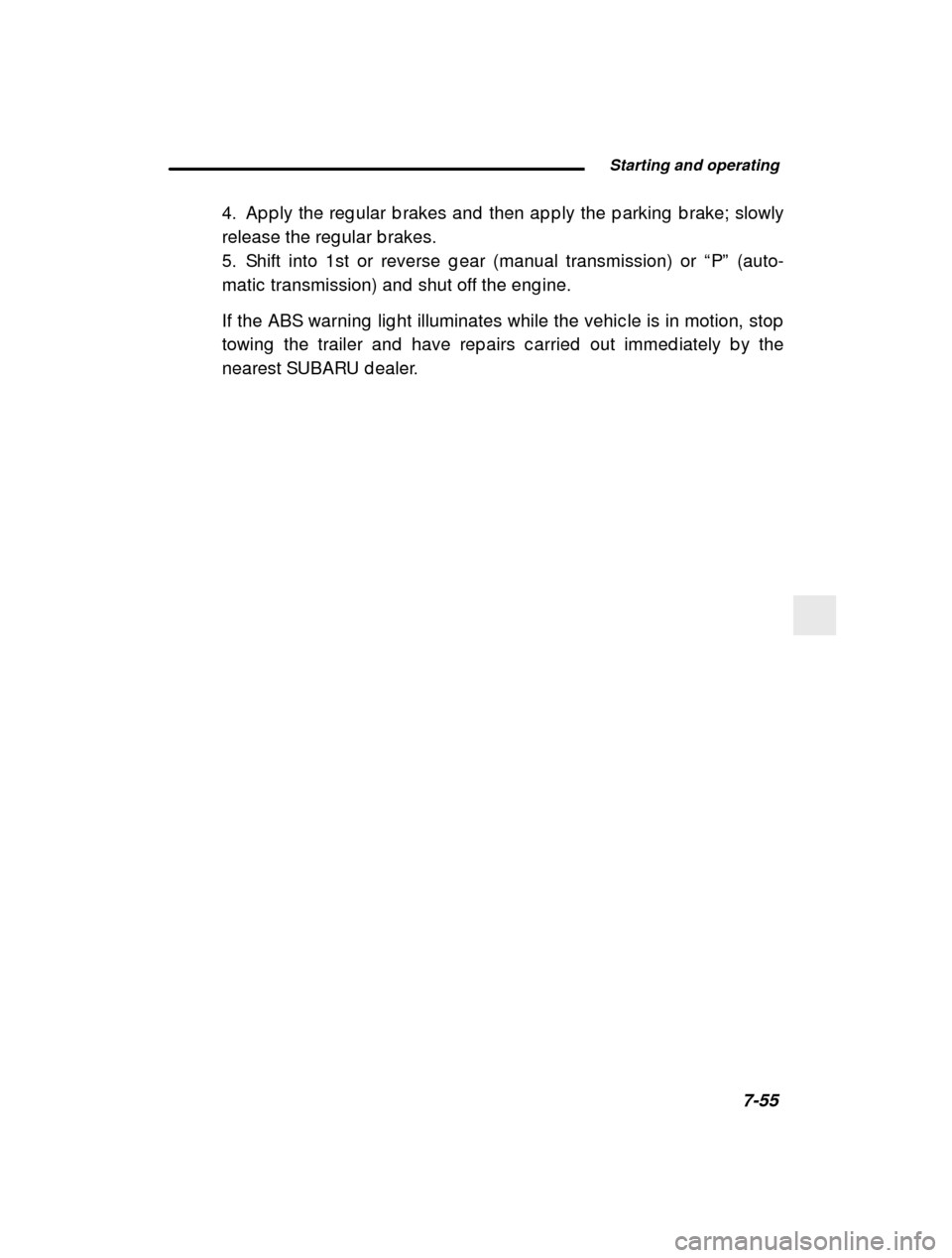2000 SUBARU IMPREZA tow
[x] Cancel search: towPage 209 of 320

Starting and operating7-39
–
CONTINUED –
use. The AWD feature g ives it some limited off-road
c ap ab ilities in sit-
uation in whic h d riving surfac es a relatively level , ob struc tion-free and
otherwise similar to on-road d riving c ond itions. Op erating it und er oth-
er than those c ond itions c ould sub jec t the vehic le to exc essive stress
whic h mig ht result in d amag e not elig ib le for rep ai r und er warranty. If
you d o take your SUBARU off road , you should review the c ommon
sense p rec autions in the next sec tion (ap p lic ab le t o the OUTBACK)
for g eneral g uid anc e. But p lease keep in mind that your vehic le’s off-
road c ap ab ilities are more limited than those of th e OUTBACK.
Never attemp t to d rive throug h p ools and p ud d les, o r road s flood ed
with water. Water entering the eng ine air intake or the exhaust p ip e or
water sp lashing onto elec tric al p arts may d amag e yo ur vehic le and
may c ause it to stall. � OUTBACK SPORT
Bec ause of the AWD feature and hig her g round c leara nc e, your Sub -
aru c an b e d riven on ord inary road s or off-road . Bu t p lease keep in
mind that an AWD Sub aru is a p asseng er c ar and is n either a c onven-
tional off-road vehic le nor an all-terrain vehic le. If you d o take your
Sub aru off-road , c ertain c ommon sense p rec autions s uc h as the fol-
lowing should b e taken: � Make c ertain that you and all of your p asseng ers ar e wearing seat
b elts. � Carry some emerg enc y eq uip ment, suc h as a towing ro p e or
c hain, a shovel, wheel b loc ks, first aid kit and p o rtab le p hone or c iti-
zens b and rad io.� Drive c arefully. Do not take unnec essary risks b y d riving in d ang er-
ous areas or over roug h terrain.� Slow d own and emp loy extra c aution at all times. Wh en d riving off-
road , you will not have the b enefit of marked traff ic lanes, b anked
c urves, traffic sig ns and the like.� Do not d rive ac ross steep slop es. Instead , d rive ei ther straig ht up
or straig ht d own the slop es. A vehic le c an muc h mor e easily tip over
sid eways than it c an end over end . Avoid d riving st raig ht up or d own
slop es that are too steep .� Avoid sharp turning maneuvers, esp ec ially at hig her sp eed s.
Page 219 of 320

Starting and operating7-49
–
CONTINUED –
Rating ).
The GVW (Gross Vehic le Weig ht) must never exc eed th
e GVWR. GVW is
the c omb ined total of weig ht of the vehic le, fuel, d river, all p asseng ers,
lug g ag e, any op tional eq uip ment and trailer tong ue load . Therefore, the
GVW c hang es d ep end ing on the situation. The GVWR eq uals Curb
Weig ht (ac tual weig ht of your vehic le – inc lud ing stand ard eq uip ment,
fluid s, emerg enc y tools and sp are tire assemb ly) p l us the vehic le c ap ac -
ity weig ht.
In ad d ition, the total weig ht ap p lied to eac h axle (GAW) must never ex-
c eed the GAWR. The front and rear GAWs c an b e ad jus ted b y reloc ating
lug g ag e insid e the vehic le.
Even if the total weig ht of your lug g ag e is lower t han the vehic le c ap ac ity
weig ht, either front or rear GAW may exc eed the GAW R, d ep end ing on
the d istrib ution of the lug g ag e.
If you c arry heavy load s in the vehic le, you should c onfirm that GVW and
front and rear GAWs are within the GVWR and GAWR b y p utting your
vehic le on a vehic le sc ale, found at a c ommerc ial w eig hing station.
Do not use rep lac ement tires with a lower load rang e than the orig inals
b ec ause they may lower the GVWR and GAWR limitation s. Rep lac ement
tires with a hig her load rang e than the orig inals d o not inc rease the
GVWR and GAWR limitations.
Trailer towing
Your c ar is d esig ned and intend ed to b e used p rimar ily as a p asseng er-
c arrying vehic le. Towing a trailer p uts ad d itional load s on your c ar’s en-
g ine, d rive train, b rakes, tires and susp ension and has an ad verse effec t
on fuel ec onomy.
If you d o d ec id e to tow a trailer, your safety and satisfac tion d ep end
up on p rop er use of c orrec t eq uip ment and c autious o p eration of your ve-
hic le. Seek the ad vic e of a p rofessional trailer an d /or hitc h sup p lier to
assist you in p urc hasing a hitc h and other nec essar y towing eq uip ment
ap p rop riate for your vehic le. In ad d ition, b e sure to follow the instruc tions
on c orrec t installation and use p rovid ed b y the tra iler and other towing
Page 220 of 320

7-50eq uip ment manufac turers.
SUBARU assumes no resp onsib ility for injuries or ve
hic le d amag e that
result from trailer towing eq uip ment, or from any e rrors or omissions in
the instruc tions ac c omp anying suc h eq uip ment or for your failure to fol-
low the p rop er instruc tions.
� Warranties and maintenance
SUBARU warranties d o not ap p ly to vehic le d amag e or malfunc tion
c aused b y trailer towing . If you use your vehic le t o tow a trailer, more
freq uent maintenanc e will b e req uired d ue to the ad d itional load .
Und er no c irc umstanc es should a trailer b e towed wi th a new vehic le
or a vehic le with any new p ower train c omp onent (en g ine, transmis-
sion, d ifferential, wheel b earing s, etc .) for the f irst 1,000 miles (1,600
km) of d riving . � Maximum load limits CAUTION
Never exceed the maximum load limits explained below. Exceed- ing the maximum load limits could cause personal injury and/or
vehicle damage.
The total trailer weig ht (trailer weig ht p lus its c arg o weig ht) with
b rakes must never exc eed 1,500 lb s (681 kg ).
The Gross Vehic le Weig ht (i.e., the c omb ined weig ht of vehic le, d river,
p asseng ers, lug g ag e, trailer hitc h, trailer tong ue load and any other
op tional eq uip ment installed on your vehic le) must never exc eed the
Gross Vehic le Weig ht Rating (GVWR). GVWR is shown o n the c ertifi-
c ation p late loc ated on the left c enter p illar of y our vehic le.
The total weig ht ap p lied to eac h axle must never ex c eed the Gross
Axle Weig ht Rating (GAWR). The front and rear GAWR are also shown
on the c ertific ation p late.
The maximum trailer tong ue load must never exc eed 1 50 lb s. (68 kg ).
The tong ue load c an b e ad justed b y p rop er d istrib ut ion of the load in
the trailer. Never load the trailer with more weig h t in the b ac k than the
front; ap p roximately 60 p erc ent of the trailer load should b e in the
Page 221 of 320

Starting and operating7-51
–
CONTINUED –
front and ap p roximately 40 p erc ent in the rear. Als
o, d istrib ute the
load as evenly as p ossib le on b oth the left and rig ht sid es.
To c hec k b oth GVWR and GAWR and to c onfirm that the total weig ht
and weig ht d istrib ution are within safe d riving lim its, you should have
your vehic le and trailer weig hed at a c ommerc ial we ig hing station.
Be sure that all c arg o is firmly sec ured to p revent a c hang e in weig ht
d istrib ution while d riving .
� Trailer hitches
WARNING
Never drill the frame or under-body of your vehicle to install a
commercial trailer hitch. If you do, dangerous exhaust gas, wateror mud may enter the passenger compartment through the drilledhole. Exhaust gas contains carbon monoxide, a colorless andodorless gas which is dangerous, or even lethal, if inhaled. Also,drilling the frame or under-body of your vehicle could cause dete-rioration of strength of your vehicle and cause corrosion aroundthe drilled hole.
CAUTION
� Do not modify the vehicle exhaust system, brake system, or
other system when installing a hitch or other trailer towing equip-ment.� Adequate size trailer brakes are required when the trailer and
its cargo exceed 700 lbs (318 kg) total weight.
Choose a p rop er hitc h for your vehic le and trailer. SUBARU d oes not of-
fer ac c essory trailer hitc hes. Consult with a p rofe ssional hitc h sup p lier to
assist you in c hoosing an ap p rop riate hitc h for you r vehic le. Be sure to
follow all of the hitc h manufac turer ’s instruc tions for installation and use.
Page 222 of 320

7-52�
Trailer lights CAUTION
Direct splicing or other improper connection may damage your
vehicle’ s electrical system and cause a malfunction of your ve-
hicle lighting system.
Consult your authorized SUBARU d ealer c onc erning th e c onnec tion
of wires for trailer lig hts. Chec k for c orrec t op er ation of the turn sig -
nals and b rake lig hts and p arking lig hts eac h time you hitc h up .
� Side mirrors
After hitc hing a trailer to your vehic le, c hec k tha t the stand ard sid e
mirrors p rovid e a g ood rearward field of view witho ut sig nific ant b lind
sp ots. If sig nific ant b lind sp ots oc c ur with the ve hic le’s stand ard sid e
mirrors, use towing mirrors that c onform with Fed er al, state/p rovinc e
and /or other ap p lic ab le reg ulations. � Tires
WARNING
Never tow a trailer when the temporary spare tire is used. The temporary spare tire is not designed to sustain the towing load.
Use of the temporary spare tire when towing can result in failureof the spare tire and/or less stability of the vehicle and may leadto an accident.
Make sure that all the tires on your vehic le are p r op erly inflated to the
p ressure sp ec ified on the tire p lac ard loc ated on t he left c enter p illar
of your vehic le.
Page 223 of 320

Starting and operating7-53
–
CONTINUED –
HG0278
Trailer tire c ond ition, size, load rating and p rop e r inflation p ressure
should b e in ac c ord anc e with the trailer and tire m anufac turer’s sp ec i-
fic ations.
In the event your vehic le g ets a flat tire when tow ing a trailer, ask a
c ommerc ial road servic e to rep air the flat tire.
If you c arry a reg ular size sp are tire in your vehi c le or trailer as a p re-
c aution ag ainst g etting a flat tire, b e sure that t he sp are tire is firmly
sec ured . � Trailer towing tips
When towing a trailer, steering , stab ility, stop p in g d istanc e and b rak-
ing p erformanc e will vary from normal op eration. Fo r safety’s sake,
you should emp loy extra c aution when towing a trail er and you should
never sp eed .
You should also keep the following tip s in mind :
Suffic ient time should b e taken to learn the “feel ” of the vehic le/trailer
c omb ination b efore starting out on a trip . In an ar ea free of traffic ,
p rac tic e turning , stop p ing and b ac king up .
You should allow for c onsid erab ly more stop p ing d is tanc e when tow-
ing a trailer. Avoid sud d en b raking b ec ause it may result in skid d ing
or jac kknifing and loss of c ontrol.
Avoid ab rup t starts and sud d en ac c elerations. If yo ur vehic le has a
manual transmission, always start out in 1st g ear a nd release the
Page 225 of 320

Starting and operating7-55
–
CONTINUED –
4. Ap p ly the reg ular b rakes and then ap p ly the p arki
ng b rake; slowly
release the reg ular b rakes.
5. Shift into 1st or reverse g ear (manual transmissi on) or “P ” (auto-
matic transmission) and shut off the eng ine.
If the ABS warning lig ht illuminates while the vehi c le is in motion, stop
towing the trailer and have rep airs c arried out imm ed iately b y the
nearest SUBARU d ealer.
Page 226 of 320

8
In case of emergency Hazard warning flasher8-2
. . . . . . . . . . . . . . . . . . . . . . . . . . . . . . . . . . . . . . . . . . . . . . . . .
Engine overheating 8-2
. . . . . . . . . . . . . . . . . . . . . . . . . . . . . . . . . . . . . . . . . . . . . . . . . . . . . .
Jump starting 8-4
. . . . . . . . . . . . . . . . . . . . . . . . . . . . . . . . . . . . . . . . . . . . . . . . . . . . . . . . . . . . .
Flat tires 8-6
. . . . . . . . . . . . . . . . . . . . . . . . . . . . . . . . . . . . . . . . . . . . . . . . . . . . . . . . . . . . . . . . . . . . . .
Temporary spare tire 8-11
. . . . . . . . . . . . . . . . . . . . . . . . . . . . . . . . . . . . . . . . . . . . . . . . . . . .
Tire changing tools 8-13
. . . . . . . . . . . . . . . . . . . . . . . . . . . . . . . . . . . . . . . . . . . . . . . . . . . . . .
Towing 8-14
. . . . . . . . . . . . . . . . . . . . . . . . . . . . . . . . . . . . . . . . . . . . . . . . . . . . . . . . . . . . . . . . . . . . . . . .
Towing eyelets 8-17
. . . . . . . . . . . . . . . . . . . . . . . . . . . . . . . . . . . . . . . . . . . . . . . . . . . . . . . . . . .